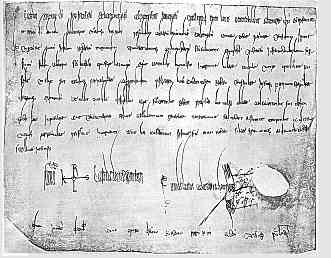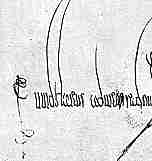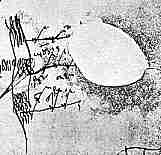





If you are looking at this page without frames, there is more information about medieval writing to be found by going to the home page (framed) or the site map (no frames).
| Diplomas (2) | |||
| While there were changes in style to the diploma over the course of the medieval era, the basic format remained remarkably consistent over many centuries. | |||
 |
Diploma of Charlemagne of 781, granting land to the abbey of Fulda (Marburg, K. Preussisches Staatsarchiv). (From Steffens 1929) | ||
| The solemn nature and religious overtone of the document is symbolised by a curly sign in the top left of the page. This is called a Chrismon and represents the name of Christ. It may be derived from the crucifix symbol, or from the chi-rho monogram for Christ constructed from the Greek letters for X and P. In some documents it develops very elaborate spiralling designs and appears to incorporate the letter C. Whatever its derivation, it signifies the importance of the document and its content. | |||
 |
|||
| It begins with an inscription containing the name and title of the monarch in an elaborate compressed heading. According to Steffens this reads Carolus gratia dei rex Francorum et Langobardorum ac patricius Romanorum, and as far as I am concerned, we will just have to believe him. In later diplomas the heading becomes even more compressed, with tall rectangular letters. Then follows the body of the grant, with more elegance of language than legal precision. | |||
 |
|||
| The validation clause of the document contains a number of complicated elements. The word Signum, spelled signu with an elaborate abbreviation mark above the u, is followed by the monogram of the king and then the words Caroli gloriosissimi regis. This is not an autograph signature. All the great man did with his own hand was join the four arms of the cross in the monogram together. This can apparently be seen as the ink which joins them is a different colour, but this reproduction does not show that, so we will have to believe those who have examined the original. | |||
 |
After this there is another Chrismon sign, followed by the name of the royal notary who drew up the document. | ||
 |
Then follows a design of highly elaborate wiggles and squiggles, interspersed with strange unrecognisable symbols. This is the notary's individual sign. It includes an inscription in the form of shorthand known as Tironian notes, which all acts as a form of encrypted authentication. The wax seal was formerly attached to the face of the document beside it, but it has vanished. | ||
 |
|||
| The document concludes with the date written across the bottom. | |||
| In comparison to English charters or writs, there is a much more complex process of written validation within the document. In England the royal chancery just attached a very big seal to the parchment sheet and relied on the listed witnesses to testify to the validity of the content. In this type of diploma, there are various tests of validity encoded into the writing itself. | |||
|
|
|||
|
|
|||
|
If you are looking at this page without frames, there is more information about medieval writing to be found by going to the home page (framed) or the site map (no frames). |
|||